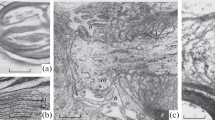Abstract.
The relationship between the changes in the passive paranodal properties of the myelinated human motor nerve fibres and the conduction abnormalities obtained is examined on the basis of a double-cable model. Simulated systematic demyelination (all paranodal regions uniformly affected) and focal demyelination (paranodal regions at each end of a single internode affected) of the fibres are defined as a reduction of the paranodal seal resistance. By increasing the degree of demyelination, the kinetics of the action potentials and ionic currents in different segments of the fibres are explored. The altered paranodal seal resistance is found to be a factor impeding the invasion of the demyelinated regions by an action potential. We established that the conduction along the most severely demyelinated fibres (i.e. in the case of systematically demyelinated fibres) is more affected than along the focally demyelinated fibres.
Similar content being viewed by others
Author information
Authors and Affiliations
Additional information
Received: 8 July 1996/Accepted in revised form: 13 December 1996
Rights and permissions
About this article
Cite this article
Stephanova, D., Chobanova, M. Action potentials and ionic currents through paranodally demyelinated human motor nerve fibres: computer simulations. Biol Cybern 76, 311–314 (1997). https://doi.org/10.1007/s004220050342
Issue Date:
DOI: https://doi.org/10.1007/s004220050342




